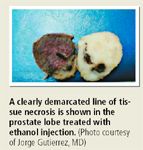Article
For BPH, alcohol ablation's efficacy equals TURP's
Author(s):
New Hyde Park, NY--Although transurethral resection of the prostate remains the gold standard for the treatment of BPH, the expense of the treatment can be too much for some patients.

Transurethral ethanol ablation of the prostate (TEAP) is a considerably less expensive procedure that can relieve BPH symptoms without relieving health care systems and the patients they serve of health care dollars, said Gopal Badlani, MD, chief of the division of neurourology and prosthetics at Long Island Jewish Medical Center, New Hyde Park, NY.
"Most of the minimally invasive prostate therapies being used in the United States do not have such an application. This is one treatment that can potentially have a worldwide application because the initial costs are not there, and the cost of injecting alcohol is very small," Dr. Badlani said.
At this year's AUA annual meeting, Dr. Badlani presented data on 279 men who underwent the procedure at 37 institutions worldwide. Ethanol injection was performed with the ProstaJect injection system (American Medical Systems, Minnetonka, MN), and alcohol dose was determined by prostate size. The procedure is not FDA approved for use in the United States.
The trials used an anhydrous solution injected into the prostate's lateral lobes. The injection procedure is conducted with a curved needle and syringe that are inserted through a standard cystoscope sheath. The procedure takes about 20 minutes.
Urinary catheter was left in place for 96 hours, and follow-up occurred at 1, 3, 6, 12, and 24 months. Subjects were evaluated for International Prostate Symptom Score (IPSS), quality of life, and Qmax scores.
Within the report were data on 157 men who have been followed for 1 year and 20 whose follow-up has reached 2 years. By the 6-month evaluation, patients showed a 52% to 55% improvement in IPSS and quality of life scores, and Qmax showed a 45% improvement. These improvements were sustained over 2 years.
The only severe adverse event reported during the initial European study were a near total necrosis of the bladder in two patients, thought to result from inappropriate ethanol diffusion. These events have not been repeated, said Dr. Badlani, who noted that a modified technique used in the study's U.S. arm showed a 15% reduction in the incidence of irritative voiding, hematuria, urinary retention, and urinary tract infections as compared with findings from other nations.
"This matches any minimally invasive treatment out there," he said. "The treatment time is much shorter than TURP, but the catheterization is slightly longer. Ethanol patients require 3 to 5 days of catheterization, whereas TURP patients-at least in the United States-require 3 days. Most of the minimally invasive treatments require 5 to 7 days or longer depending on the energy source being used."
Dr. Badlani is a consultant to American Medical Systems.

















